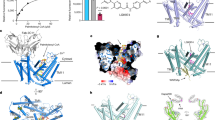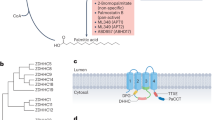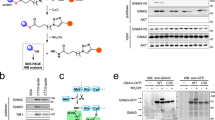Abstract
Wnt proteins are critical regulators of signaling networks during embryonic development and in adult tissue homeostasis. The generation of active Wnt proteins requires their regulated secretion into the extracellular space. Once secreted, Wnts signal through the cell surface via receptor binding on Wnt-receiving cells, a mechanism that is prevalent in stem cell and cancer biology. Important to both Wnt secretion and receptor recognition is their post-translational fatty acylation. In this Perspective, we highlight progress in elucidating the biochemistry of Wnt fatty acylation and provide a molecular view on the enzymology of substrate recognition and catalysis, with a focus on the Wnt O-acyltransferase porcupine. Special emphasis is given to Wnt fatty acid biosynthesis, Wnt-porcupine interactions, clinical mutations of porcupine and emerging therapeutics for perturbing Wnt fatty acylation in cancer. Finally, we discuss models for the functional role of the unsaturated fatty acyl chain in mediating lipid-protein interactions and in Wnt trafficking.
This is a preview of subscription content, access via your institution
Access options
Subscribe to this journal
Receive 12 print issues and online access
$259.00 per year
only $21.58 per issue
Buy this article
- Purchase on Springer Link
- Instant access to full article PDF
Prices may be subject to local taxes which are calculated during checkout







Similar content being viewed by others
References
Srivastava, M. et al. The Trichoplax genome and the nature of placozoans. Nature 454, 955–960 (2008).
Kusserow, A. et al. Unexpected complexity of the Wnt gene family in a sea anemone. Nature 433, 156–160 (2005).
Holstein, T.W. The evolution of the Wnt pathway. Cold Spring Harb. Perspect. Biol. 4, a007922 (2012).
Nusse, R. & Varmus, H.E. Many tumors induced by the mouse mammary tumor virus contain a provirus integrated in the same region of the host genome. Cell 31, 99–109 (1982).
Sharma, R.P. & Chopra, V.L. Effect of the Wingless (wg1) mutation on wing and haltere development in Drosophila melanogaster. Dev. Biol. 48, 461–465 (1976).
Rijsewijk, F. et al. The Drosophila homolog of the mouse mammary oncogene int-1 is identical to the segment polarity gene wingless. Cell 50, 649–657 (1987).
Willert, K. & Nusse, R. Wnt proteins. Cold Spring Harb. Perspect. Biol. 4, a007864 (2012).
MacDonald, B.T. et al. Disulfide bond requirements for active Wnt ligands. J. Biol. Chem. 289, 18122–18136 (2014).
Cui, M., Siriwon, N., Li, E., Davidson, E.H. & Peter, I.S. Specific functions of the Wnt signaling system in gene regulatory networks throughout the early sea urchin embryo. Proc. Natl. Acad. Sci. USA 111, E5029–E5038 (2014).
Wang, J., Sinha, T. & Wynshaw-Boris, A. Wnt signaling in mammalian development: lessons from mouse genetics. Cold Spring Harb. Perspect. Biol. 4, a007963 (2012).
Kikuchi, A., Yamamoto, H., Sato, A. & Matsumoto, S. in International Review of Cell and Molecular Biology (ed. Kwang, W.J.) 21–71 (Academic Press, 2011).
Niehrs, C. The complex world of WNT receptor signalling. Nat. Rev. Mol. Cell Biol. 13, 767–779 (2012).
Malinauskas, T. & Jones, E.Y. Extracellular modulators of Wnt signalling. Curr. Opin. Struct. Biol. 29, 77–84 (2014).
Polakis, P. Wnt signaling in cancer. Cold Spring Harb. Perspect. Biol. 4, a008052 (2012).
Clevers, H. & Nusse, R. Wnt/β-catenin signaling and disease. Cell 149, 1192–1205 (2012).
Van Camp, J.K., Beckers, S., Zegers, D. & Van Hul, W. Wnt signaling and the control of human stem cell fate. Stem Cell Rev. 10, 207–229 (2014).
Willert, K. et al. Wnt proteins are lipid-modified and can act as stem cell growth factors. Nature 423, 448–452 (2003).
Takada, R. et al. Monounsaturated fatty acid modification of Wnt protein: its role in Wnt secretion. Dev. Cell 11, 791–801 (2006).
Janda, C.Y., Waghray, D., Levin, A.M., Thomas, C. & Garcia, K.C. Structural basis of Wnt recognition by Frizzled. Science 337, 59–64 (2012). Provides the first co-crystal structure of Xenopus Wnt8 in complex with a soluble mFZD8 CRD, demonstrating a lipid-protein interaction.
Hannoush, R.N. & Arenas-Ramirez, N. Imaging the lipidome: omega-alkynyl fatty acids for detection and cellular visualization of lipid-modified proteins. ACS Chem. Biol. 4, 581–587 (2009). Reports the development of nonradioactive alkyne fatty acid probes of different chain lengths for detecting protein fatty acylation (palmitoylation and myristoylation).
Gao, X., Arenas-Ramirez, N., Scales, S.J. & Hannoush, R.N. Membrane targeting of palmitoylated Wnt and Hedgehog revealed by chemical probes. FEBS Lett. 585, 2501–2506 (2011).
Gao, X. & Hannoush, R.N. Single-cell imaging of Wnt palmitoylation by the acyltransferase porcupine. Nat. Chem. Biol. 10, 61–68 (2014). Reports a click-based technology to visualize palmitoylated forms of Wnt proteins in cells, porcupine fatty acid substrate preference, incorporation of fatty acids of different chain lengths by Wnts, and S-palmitoylation of human porcupine.
Miranda, M. et al. Identification of the WNT1 residues required for palmitoylation by Porcupine. FEBS Lett. 588, 4815–4824 (2014).
Dijksterhuis, J.P. et al. Systematic mapping of WNT-FZD protein interactions reveals functional selectivity by distinct WNT-FZD pairs. J. Biol. Chem. 290, 6789–6798 (2015).
Bhanot, P. et al. A new member of the frizzled family from Drosophila functions as a Wingless receptor. Nature 382, 225–230 (1996).
Ching, W., Hang, H.C. & Nusse, R. Lipid-independent secretion of a Drosophila Wnt protein. J. Biol. Chem. 283, 17092–17098 (2008).
Chu, M.L.-H. et al. structural Studies of Wnts and identification of an LRP6 binding site. Structure 21, 1235–1242 (2013). Describes the structure of the N-terminal domain and a linker of the C-terminal domain of Drosophila WntD, revealing a fist-like conformation of the thumb region.
Hannoush, R.N. Synthetic protein lipidation. Curr. Opin. Chem. Biol. 28, 39–46 (2015).
Rios-Esteves, J. & Resh, M.D. Stearoyl CoA desaturase is required to produce active, lipid-modified Wnt proteins. Cell Rep. 4, 1072–1081 (2013). Identifies Scd1 as a key player required for fatty acylation of Wnt3a and Wnt5a.
Omary, M.B. & Trowbridge, I.S. Biosynthesis of the human transferrin receptor in cultured cells. J. Biol. Chem. 256, 12888–12892 (1981).
Pepinsky, R.B. et al. Identification of a palmitic acid-modified form of human Sonic hedgehog. J. Biol. Chem. 273, 14037–14045 (1998).
Buglino, J.A. & Resh, M.D. Hhat is a palmitoylacyltransferase with specificity for N-palmitoylation of Sonic Hedgehog. J. Biol. Chem. 283, 22076–22088 (2008).
Hodson, L. & Fielding, B.A. Stearoyl-CoA desaturase: rogue or innocent bystander? Prog. Lipid Res. 52, 15–42 (2013).
Kihara, A. Very long-chain fatty acids: elongation, physiology and related disorders. J. Biochem. 152, 387–395 (2012).
Mashek, D.G., Li, L.O. & Coleman, R.A. Long-chain acyl-CoA synthetases and fatty acid channeling. Future Lipidol. 2, 465–476 (2007).
Enoch, H.G., Catalá, A. & Strittmatter, P. Mechanism of rat liver microsomal stearyl-CoA desaturase. Studies of the substrate specificity, enzyme-substrate interactions, and the function of lipid. J. Biol. Chem. 251, 5095–5103 (1976).
Fox, B.G., Lyle, K.S. & Rogge, C.E. Reactions of the diiron enzyme stearoyl-acyl carrier protein desaturase. Acc. Chem. Res. 37, 421–429 (2004).
Bai, Y. et al. X-ray structure of a mammalian stearoyl-CoA desaturase. Nature 524, 252–256 (2015). Reports the structure of human stearoyl-CoA desaturase 1 in complex with C18:0-CoA, providing a structural basis for the regioselective and stereoselective dehydrogenation reaction.
Wang, H. et al. Crystal structure of human stearoyl-coenzyme A desaturase in complex with substrate. Nat. Struct. Mol. Biol. 22, 581–585 (2015).
Shanklin, J., Whittle, E. & Fox, B.G. Eight histidine residues are catalytically essential in a membrane-associated iron enzyme, stearoyl-CoA desaturase, and are conserved in alkane hydroxylase and xylene monooxygenase. Biochemistry 33, 12787–12794 (1994).
Hofmann, K. A superfamily of membrane-bound O-acyltransferases with implications for wnt signaling. Trends Biochem. Sci. 25, 111–112 (2000).
Kadowaki, T., Wilder, E., Klingensmith, J., Zachary, K. & Perrimon, N. The segment polarity gene porcupine encodes a putative multitransmembrane protein involved in Wingless processing. Genes Dev. 10, 3116–3128 (1996).
van den Heuvel, M., Harryman-Samos, C., Klingensmith, J., Perrimon, N. & Nusse, R. Mutations in the segment polarity genes wingless and porcupine impair secretion of the wingless protein. EMBO J. 12, 5293–5302 (1993).
Rios-Esteves, J., Haugen, B. & Resh, M.D. Identification of key residues and regions important for porcupine-mediated Wnt acylation. J. Biol. Chem. 289, 17009–17019 (2014). Examines Wnt3a-porcupine interactions and the importance of FDH-related and other mutations on porcupine activity.
Konitsiotis, A.D. et al. Topological analysis of Hedgehog acyltransferase, a multipalmitoylated transmembrane protein. J. Biol. Chem. 290, 3293–3307 (2015).
Covey, T.M. et al. PORCN moonlights in a Wnt-independent pathway that regulates cancer cell proliferation. PLoS One 7, e34532 (2012).
Proffitt, K.D. & Virshup, D.M. Precise regulation of porcupine activity is required for physiological Wnt signaling. J. Biol. Chem. 287, 34167–34178 (2012).
Bornholdt, D. et al. PORCN mutations in focal dermal hypoplasia: coping with lethality. Hum. Mutat. 30, E618–E628 (2009).
Froyen, G. et al. Novel PORCN mutations in focal dermal hypoplasia. Clin. Genet. 76, 535–543 (2009).
Lombardi, M.P. et al. Mutation update for the PORCN gene. Hum. Mutat. 32, 723–728 (2011).
Nakanishi, G. et al. Novel and recurrent PORCN gene mutations in almost unilateral and typical focal dermal hypoplasia patients. Eur. J. Dermatol. 23, 64–67 (2013).
Wang, X. et al. Mutations in X-linked PORCN, a putative regulator of Wnt signaling, cause focal dermal hypoplasia. Nat. Genet. 39, 836–838 (2007). Established the first connection between mutations in porcupine and the X-linked dominant disorder focal dermal hypoplasia (FDH).
Murakami, C. et al. Focal dermal hypoplasia: a case report and literature review. Oral Surg. Oral Med. Oral Pathol. Oral Radiol. Endod. 112, e11–e18 (2011).
Liu, W. et al. Deletion of Porcn in mice leads to multiple developmental defects and models human focal dermal hypoplasia (Goltz syndrome). PLoS One 7, e32331 (2012).
Barrott, J.J., Cash, G.M., Smith, A.P., Barrow, J.R. & Murtaugh, L.C. Deletion of mouse Porcn blocks Wnt ligand secretion and reveals an ectodermal etiology of human focal dermal hypoplasia/Goltz syndrome. Proc. Natl. Acad. Sci. USA 108, 12752–12757 (2011).
Biechele, S., Cox, B.J. & Rossant, J. Porcupine homolog is required for canonical Wnt signaling and gastrulation in mouse embryos. Dev. Biol. 355, 275–285 (2011).
Caricasole, A., Ferraro, T., Rimland, J.M. & Terstappen, G.C. Molecular cloning and initial characterization of the MG61/PORC gene, the human homologue of the Drosophila segment polarity gene Porcupine. Gene 288, 147–157 (2002).
Chen, B. et al. Small molecule-mediated disruption of Wnt-dependent signaling in tissue regeneration and cancer. Nat. Chem. Biol. 5, 100–107 (2009).
Dodge, M.E. et al. Diverse chemical scaffolds support direct inhibition of the membrane-bound O-acyltransferase porcupine. J. Biol. Chem. 287, 23246–23254 (2012).
Ho, R., Papp, B., Hoffman, J.A., Merrill, B.J. & Plath, K. Stage-specific regulation of reprogramming to induced pluripotent stem cells by Wnt signaling and T cell factor proteins. Cell Rep. 3, 2113–2126 (2013).
Ross, J. et al. A rare human syndrome provides genetic evidence that WNT signaling is required for reprogramming of fibroblasts to induced pluripotent stem cells. Cell Rep. 9, 1770–1780 (2014).
Wang, X. et al. The development of highly potent inhibitors for porcupine. J. Med. Chem. 56, 2700–2704 (2013).
Cheng, D., Zhang, G., Han, D., Gao, W. & Pan, S. US patent publication US 101849 (2010).
Proffitt, K.D. et al. Pharmacological inhibition of the Wnt acyltransferase PORCN prevents growth of WNT-driven mammary cancer. Cancer Res. 73, 502–507 (2013). Provides proof of concept for pharmacological targeting of porcupine by using the small-molecule inhibitor C59 in mouse mammary xenograft models.
Koo, B.K., van Es, J.H., van den Born, M. & Clevers, H. Porcupine inhibitor suppresses paracrine Wnt-driven growth of Rnf43;Znrf3-mutant neoplasia. Proc. Natl. Acad. Sci. USA 112, 7548–7550 (2015).
Liu, J. et al. Targeting Wnt-driven cancer through the inhibition of Porcupine by LGK974. Proc. Natl. Acad. Sci. USA 110, 20224–20229 (2013). Describes the identification of a small-molecule inhibitor of porcupine that shows efficacy and is well tolerated in rodent tumor models.
Jiang, X. et al. Inactivating mutations of RNF43 confer Wnt dependency in pancreatic ductal adenocarcinoma. Proc. Natl. Acad. Sci. USA 110, 12649–12654 (2013).
Madan, B. et al. Wnt addiction of genetically defined cancers reversed by PORCN inhibition. Oncogene doi:10.1038/onc.2015.280 (2015).
Gross, J.C., Chaudhary, V., Bartscherer, K. & Boutros, M. Active Wnt proteins are secreted on exosomes. Nat. Cell Biol. 14, 1036–1045 (2012).
Bänziger, C. et al. Wntless, a conserved membrane protein dedicated to the secretion of Wnt proteins from signaling cells. Cell 125, 509–522 (2006).
Mulligan, K.A. et al. Secreted Wingless-interacting molecule (Swim) promotes long-range signaling by maintaining Wingless solubility. Proc. Natl. Acad. Sci. USA 109, 370–377 (2012).
Kakugawa, S. et al. Notum deacylates Wnt proteins to suppress signalling activity. Nature 519, 187–192 (2015). Reports the first known extracellular protein deacylase that specifically targets Wnts, revealing a novel extracellular regulatory mechanism.
Zhang, X. et al. Notum is required for neural and head induction via Wnt deacylation, oxidation, and inactivation. Dev. Cell 32, 719–730 (2015).
Panáková, D., Sprong, H., Marois, E., Thiele, C. & Eaton, S. Lipoprotein particles are required for Hedgehog and Wingless signalling. Nature 435, 58–65 (2005).
Herr, P. & Basler, K. Porcupine-mediated lipidation is required for Wnt recognition by Wls. Dev. Biol. 361, 392–402 (2012).
Bartscherer, K., Pelte, N., Ingelfinger, D. & Boutros, M. Secretion of Wnt ligands requires Evi, a conserved transmembrane protein. Cell 125, 523–533 (2006).
Goodman, R.M. et al. Sprinter: a novel transmembrane protein required for Wg secretion and signaling. Development 133, 4901–4911 (2006).
Najdi, R. et al. A uniform human Wnt expression library reveals a shared secretory pathway and unique signaling activities. Differentiation 84, 203–213 (2012).
Coombs, G.S. et al. WLS-dependent secretion of WNT3A requires Ser209 acylation and vacuolar acidification. J. Cell Sci. 123, 3357–3367 (2010).
Yu, J. et al. WLS retrograde transport to the endoplasmic reticulum during Wnt secretion. Dev. Cell 29, 277–291 (2014).
Port, F. & Basler, K. Wnt trafficking: new insights into Wnt maturation, secretion and spreading. Traffic 11, 1265–1271 (2010).
Aicart-Ramos, C., Valero, R.A. & Rodriguez-Crespo, I. Protein palmitoylation and subcellular trafficking. Biochim. Biophys. Acta 1808, 2981–2994 (2011).
Korkut, C. et al. Trans-synaptic transmission of vesicular Wnt signals through Evi/Wntless. Cell 139, 393–404 (2009).
Beckett, K. et al. Drosophila S2 cells secrete wingless on exosome-like vesicles but the wingless gradient forms independently of exosomes. Traffic 14, 82–96 (2013).
Naguib, A. et al. p53 mutations change phosphatidylinositol acyl chain composition. Cell Rep. 10, 8–19 (2015).
Sievers, F. et al. Fast, scalable generation of high-quality protein multiple sequence alignments using Clustal Omega. Mol. Syst. Biol. 7, 539 (2011).
Okonechnikov, K., Golosova, O. & Fursov, M. UGENE team. Unipro UGENE: a unified bioinformatics toolkit. Bioinformatics 28, 1166–1167 (2012).
Notredame, C., Higgins, D.G. & Heringa, J. T-Coffee: a novel method for fast and accurate multiple sequence alignment. J. Mol. Biol. 302, 205–217 (2000).
Crooks, G.E., Hon, G., Chandonia, J.M. & Brenner, S.E. WebLogo: a sequence logo generator. Genome Res. 14, 1188–1190 (2004).
Leoyklang, P., Suphapeetiporn, K., Wananukul, S. & Shotelersuk, V. Three novel mutations in the PORCN gene underlying focal dermal hypoplasia. Clin. Genet. 73, 373–379 (2008).
Maas, S.M. et al. Phenotype and genotype in 17 patients with Goltz-Gorlin syndrome. J. Med. Genet. 46, 716–720 (2009).
Fernandes, P.H. et al. PORCN mutations and variants identified in patients with focal dermal hypoplasia through diagnostic gene sequencing. Genet. Test. Mol. Biomarkers 14, 709–713 (2010).
Nugent, T. & Jones, D.T. Detecting pore-lining regions in transmembrane protein sequences. BMC Bioinformatics 13, 169 (2012).
Omasits, U., Ahrens, C.H., Müller, S. & Wollscheid, B. Protter: interactive protein feature visualization and integration with experimental proteomic data. Bioinformatics 30, 884–886 (2014).
Chang, C.Y., Sun, J. & Chang, T.-Y. Membrane-bound O-acyltransferases (MBOATs). Front. Biol. 6, 177–182 (2011).
Buglino, J.A. & Resh, M.D. Identification of conserved regions and residues within Hedgehog acyltransferase critical for palmitoylation of Sonic Hedgehog. PLoS One 5, e11195 (2010).
Yang, J., Brown, M.S., Liang, G., Grishin, N.V. & Goldstein, J.L. Identification of the acyltransferase that octanoylates ghrelin, an appetite-stimulating peptide hormone. Cell 132, 387–396 (2008).
Das, A., Davis, M.A. & Rudel, L.L. Identification of putative active site residues of ACAT enzymes. J. Lipid Res. 49, 1770–1781 (2008).
Hardy, R.Y. & Resh, M.D. Identification of N-terminal residues of Sonic Hedgehog important for palmitoylation by Hedgehog acyltransferase. J. Biol. Chem. 287, 42881–42889 (2012).
Author information
Authors and Affiliations
Corresponding author
Ethics declarations
Competing interests
The authors declare no competing financial interests.
Rights and permissions
About this article
Cite this article
Nile, A., Hannoush, R. Fatty acylation of Wnt proteins. Nat Chem Biol 12, 60–69 (2016). https://doi.org/10.1038/nchembio.2005
Received:
Accepted:
Published:
Issue Date:
DOI: https://doi.org/10.1038/nchembio.2005
This article is cited by
-
Glutamine addiction in tumor cell: oncogene regulation and clinical treatment
Cell Communication and Signaling (2024)
-
Tumor metabolism rewiring in epithelial ovarian cancer
Journal of Ovarian Research (2023)
-
Reprogramming of palmitic acid induced by dephosphorylation of ACOX1 promotes β-catenin palmitoylation to drive colorectal cancer progression
Cell Discovery (2023)
-
ACSL5, a prognostic factor in acute myeloid leukemia, modulates the activity of Wnt/β-catenin signaling by palmitoylation modification
Frontiers of Medicine (2023)
-
PI(18:1/18:1) is a SCD1-derived lipokine that limits stress signaling
Nature Communications (2022)



